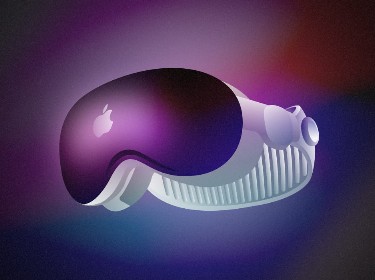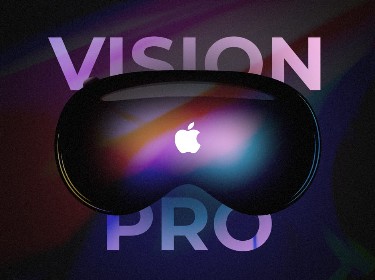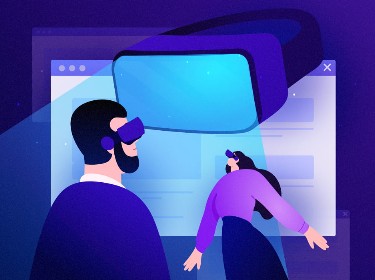A perfect tool for customer engagement, augmented reality (AR) offers a captivating and immersive experience. WebAR, for its part, raises this interaction to a new level, helping you to extend your business as never before.
Trying on masks on Instagram and TikTok, hunting for rare creatures in Pokemon GO, or relying on Google Street View to reach a destination — we interact with augmented reality (AR) without even realizing it.
Businesses started using AR technology a long time ago through mobile applications. However, people can be reluctant to use up time and storage space on an app with quite limited functionality. This means that many potential users miss out on mobileAR experiences.
Web-based AR tackles this issue — no more hesitation over whether or not to download an app: you simply engage in virtual activities right from the browser. The success of webAR is backed up by the statistics — according to the research it will reach $21 billion in market cap by 2024, with 64% of flagship brands already investing in the technology.
In this article we will dive deep into the concept of webAR, understand what technologies power it, unravel its benefits and limitations, and discover the most prominent use cases across various domains.
What is web-based augmented reality and how does it work?
WebAR is an experience enabled by adding digital elements to a real-life setting accessed via a web browser. The technology uses sensors and computer vision development to layer animated effects onto physical objects and the environment.
More advanced solutions also utilize a gyroscope, accelerometer, orientation tools and magnetometer.
For the successful implementation of webAR technology, several important conditions must be met: six degrees of freedom, camera stream, scene understanding, and cloud-based CMS. Let’s have a look at each element.
- Six degrees of freedom — a 3D image must synchronize with the real world. The webAR solution depends on its ability to track three axes of position and orientation.
- Camera stream — the camera’s field of view and perspective are used to add AR experience to a physical environment and synchronize two dimensions.
- Scene understanding — the application should understand surface and light features of the environment to correctly place virtual objects.
- Cloud CMS (content management system) — webAR experience should be accessible through various triggers (e.g. QR codes or links) to engage users anywhere anytime.
What’s more, the browser should support WebXR API to enable AR/VR content without the need to install extra plugins or software.
WebAR vs MobileAR: what are the differences?
![]()
Though sharing the same concept, webAR and mobileAR differ in several respects. The most important one regards the way they function — mobileAR solutions need to be downloaded on the device while web versions run in browsers.
Created with the characteristics of a specific platform in mind, mobileAR has elaborate visuals and more interactive options. However, many people pass over these apps, unwilling to go through the installation process. WebAR experience, on the other hand, is available from any device connected to the internet.
Another pain point of mobile AR is its cost. Development of a fully functioning application is pricey, especially when it involves 3D animation. However, that way the idea gets the best technical realization, incorporating all the hardware capabilities.
In addition, mobileAR applications are not fully dependent on internet connection, being able to store some data on the device. Meanwhile, webAR completely relies on the net access.
WebAR vs WebVR vs WebXR
Apart from web augmented reality there are other concepts such as web virtual reality (webVR) and web extended reality (webXR). We have already discovered what webAR is, but what are the other two?
In contrast to webAR, webVR doesn’t bring digital elements to the real-life environment but instead takes you from reality to the virtual world. Yet to fully immerse yourself in this world, you need a headset such as Google Cardboard, Oculus Rift or Samsung Gear VR. There are many spectacular webVR games: Up There, VRBlocks, SpaceRocks, and Witch’s Brew, to name a few.
Meanwhile, webXR is an umbrella term describing webAR and webVR. It is also often called “Mixed reality” when it represents a combination of the two. Among the most notable webXR projects are Obscura, Helicon, and Castle Builder.
Get to know more about XR and its business applications in our blog article
How to build webAR? Overview of popular frameworks
Catering to the demands of 1.1 billion AR users worldwide, many businesses and developers are highly interested in producing AR web applications.This way, brands aim to engage new people and strengthen relationships with current customers.
There are several webAR frameworks at our disposal, making it possible to design applications that are both high-performing and engaging: 8th Wall, Banuba Face AR, XR.+, BlippAR, and awe.
8th Wall
8th Wall is a cross-platform development solution for building AR experiences running on both web and mobile. Among the framework’s features are six degrees of freedom, lighting estimation, and surface detection. With 8th Wall you can animate images, create whimsical face filters and develop 3D mini-games.
8th Wall supports 3.5 billion smartphones across Android and iOS devices and is compatible with 3D JavaScript frameworks such as A-Frame, three.js, Babylon.js, PlayCanvas and Amazon Sumerian.
Banuba Face AR
Banuba Face AR is a software development kit specializing in face modifications. The framework toolset includes face detection, hair and lips segmentation, and background segmentation. These instruments allow users to create natural looking amendments to your appearance, perform virtual try-ons, and alter backgrounds.
With Banuba, you can use premade content, with each feature offered as an API, or create your own effects. Banuba supports the most popular browsers — Chrome, Firefox, and Safari.
XR.+
XR.+ is an augmented reality platform that offers a great variety of tools for the creation of engaging webAR experiences. The solution allows you to integrate one or multiple 3D objects.
These items can be static or animated: you can rotate them, zoom in or out, etc.
XR.+ supports the anchoring of products on horizontal and vertical surfaces, faces, hands, and feet. It instantly switches from one product to another, changing colors and materials.
In addition, the framework can perform alpha blending and cut off video background in one click. Hence traditional videos are turned into interactive experiences.
XR.+ is compatible with all major mobile browsers such as Chrome, Safari, Firefox, Samsung Internet, and Edge.
BlippAR
BlippAR is a framework offering webAR transformation to advertising campaigns. It is a drag and drop editor equipped with such tools as surface tracking and image recognition. A ready-to-go AR experience can be published and viewed anywhere on the web and accessed via a QR code or a URL.
awe
awe is a web-based drag and drop editing tool which helps you to create webAR pieces. awe allows you to add and animate an unlimited number of objects per scene and supports 360° scenes and gaze tracking. The solution is perfect for digital masks and filters due to its image recognition and natural feature tracking. Awe is compatible with computers, Android and iOS devices.
Don’t miss our article on how to build a metaverse — one more groundbreaking Web 3.0 solution
What are the benefits of WebAR?
![]()
WebAR boasts some huge benefits, making the lives of both users and developers much easier. Such solutions are easy to deploy and share, and they don’t require users to run updates. Plus, they are fast to develop and very convenient for collecting data analytics.
- Accessibility
As previously mentioned, webAR functions in browsers, so you don’t need to wait till the application is downloaded and installed on your device to actually use it. Follow a link or click on the button and there you are — having anime eyes or holding a cup of virtual coffee. You can return to this experience again and again from multiple devices with no storage space occupied.
- Sharing
Content generated with webAR is extremely easy to share — a link or QR-code is enough to spread webAR solutions among thousands of people.
- No updates
WebAR solutions get updated automatically, so no extra burden falls on the users’ shoulders.
From a company’s perspective, webAR is a valuable investment as there is no need to build a whole application. With web-based AR you save on money and human resources and significantly reduce deployment time while not compromising on the quality of the AR experience.
These applications are also easily integrated with Google Analytics and other tracking tools. While more people get entertained by donning masks or placing non-existent items in their rooms, companies gather relevant data for more sophisticated marketing campaigns which help to increase brand awareness.
Ever wanted to interact with your favorite characters? It’s real with Treadwater AR
What limitations does webAR face?
As webAR is still a developing technology, it has some limitations:
- Lack of accuracy
As webAR solutions can be used on multiple platforms, they are built based on standard features.This may result in inaccuracy of measurements — for example, when placing objects in the environment.
- Internet connection
WebAR depends on the speed of the internet for good performance. If the connection is unstable, the digital layer will simply not match with the environment.
- Less complexity
With no deliberately allocated storage, webAR content is less detailed and offers fewer interaction options.
Lowdown on top 5 webAR use cases
![]()
Our augmented reality software development company shortlisted the most promising sectors where WebAR can be applied. Let’s take a look at how exactly augmented reality is applied in each case.
Marketing & advertising
A brand’s investment in innovative forms of advertising is crucial, especially with COVID-19 having driven customers away from the traditional brick-and-mortar stores. With this in mind, marketers make great use of webAR technology, launching fancy campaigns with virtual try-ons or 3D animations popping up when you scan the package.
According to Google, 66% of people prefer to experience AR when shopping and 6 in 10 people like the opportunity to visualize how the item will fit their environment.
“Advanced AR and Virtual Try On deliver products directly into the shopper’s world, giving them context, inspiration and most importantly, confidence to make a purchase. AR is no longer a fun “nice to have.” It’s an immersive feature that drives results.” ― Matt Gorniak, CEO at Threekit.
One of the companies that joined the AR trend is the US retailer Jerome’s Furniture. In its webAR application users can try over 1,000 3D pieces of virtual furniture in their living environments and plan the design of the rooms. It also enables them to share their projects on social media or send to family and friends.
Education
A picture is worth a thousand words, and if it is an interactive picture it is simply ideal. Augmented reality in education presents the possibility of visualizing complex subjects such as biological or anatomical structures, space and tech models, and many more. This way, the learning process becomes much more interesting and intelligible.
A good example of webAR in education is the Augmented Classroom project. It is a browser-based platform accessible on computers, mobile devices and touch boards. Augmented Classroom lets students interactively learn and check their knowledge on topics including geography, weather, geometry and space. Besides the pre-designed content, you can create your own realities and cooperate with other schools across the globe.
Entertainment
Web-based augmented reality offers a bunch of face and body filters, games and animations — more than enough activities to fill a boring evening with fun and laughter.
Sony Pictures definitely made Spider Man’s fans day when they launched a webAR experience with the friendly neighbor appearing right in their rooms. Now users can take a picture with a superhero and share it on social media.
Business
The most interesting application of webAR in the business field is 3D business cards. By scanning a QR-code or following a link, you can enable an interactive card with the brand’s or person’s details: social media, email and so on. An additional perk for the owners of such cards is the ability to gather the analytics and understand how many people visited your “card”.
Stanley Black & Decker, an American manufacturer of industrial tools and household hardware, can boast an AR business card of its own. The web augmented reality experience features an animated 3D retro wooden ruler adorned with photorealistic details.
Tourism
There are several aspects in which webAR can significantly improve the tourism experience. First, sites steeped in history and cultural heritage can be supplied with QR codes so that visitors can scan them and unlock related materials. What’s more, geolocation-based AR can be activated automatically when a person reaches a specific location.
Next, it is often very difficult to provide information in all the languages requested — imagine how many panels a museum would have to provide for its pieces. With webAR, however, you can simply scan the artwork and choose the language you need.
Furthermore, augmented reality can enhance real-life experience by reconstructing the ruins of a once grandiose castle or by animating an ancient street to show how busy it was centuries ago.
A platform offering tools for creating tourism webAR is Onirix. It allows you to attach augmented reality experiences to historical buildings and other landmarks — information about the places and former inhabitants, commercial offers, or even hidden content for people to collect.
Take a look at how augmented reality is used in the wine industry
Conclusion
It is very clear that augmented and mixed reality technologies will continue developing at a fast pace, as participation in interactive virtual activities greatly enhances user experience. Many brands and enterprises have already incorporated augmented reality into their business strategy, achieving impressive results in terms of consumer engagement and, subsequently, sales.
WebAR is a step further, allowing you to create thrilling experiences accessible on any device with no need to launch a specially designed app. Bearing in mind the ease with which one can share webAR content, the audience reach is massive.
Want to enrich your brand’s content with augmented reality? We’re right with you on this: PixelPlex’s designers are here to create jaw-dropping visuals, while our augmented and virtual reality development specialists will create a totally absorbing experience. We can also assist with web accessibility consulting services, ensuring that your digital solutions are inclusive and accessible to all users.
Share your ideas with us and prepare to go beyond real-life boundaries.




